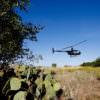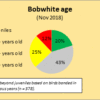
by Daniel King
This month we are discussing food plots. In my experience, food plots are one of the “go-to” practices that managers implement on a consistent basis. However, they are often implemented sub-optimally. More specifically, food plots are often put in at much too large a plot and not distributed well across the landscape.
Habitat management for bobwhites is approached from a paradigm of maximizing usable space over time. To be usable space, the three broad habitat needs (food, cover, nesting cover) must be available in sufficient quantity and interspersed adequately to allow consistent access across the space. A food plot only meets one of those needs. So, as the plot size increases and exceeds a certain threshold, you begin to lose usable space. Imagine an entire city that is made up exclusively of grocery stores, not very habitable. For this reason, I like to keep all food plots between 2 to 5 acres. In addition, I like to make the plots long and “skinny” rather than square to maximize the number of adjacent acres that are impacted. Those plots get distributed evenly across the landscape, shooting for perhaps 5 to 10% of the area.
Once you have your size, structure, and distribution of plots determined, you can decide what to plant in them. Milo, wheat, sunflower, and millet top my list of food plot crops. I like to shoot for half my plots to be cool-season and the other half warm-season crops. To plant, I prefer either a no-till seed drill or a Wood’s style seeder. I prefer these two options because they shorten or eliminate the window that the plot is “plowed under.” Remember, we are shooting for maximum usable space over time for bobwhites, not winning the county farmer of the year award. Keeping a plot bare dirt for the “off season” negates any benefit the plot might provide, and the birds will not mind a few “weeds” coming up anyway.
Overall, we need to remember that food plots fall more in the supplemental feeding category rather than true habitat management. Therefore, they will not make up for poor management, and you should weigh the time, effort, and cost of implementing them against other forms of supplemental feeding.














